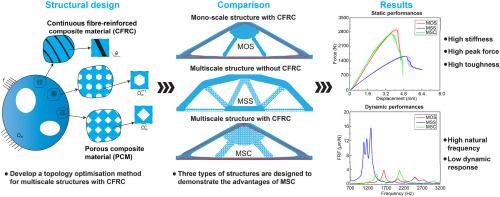Topological design and experimental characterisation of continuous fibre-reinforced composite multiscale structures
IF 9.8
1区 材料科学
Q1 MATERIALS SCIENCE, COMPOSITES
引用次数: 0
Abstract
In this study, a topology optimisation method is developed for designing a novel multiscale structure (MSS) with continuous fibre-reinforced composite materials (CFRCs) to achieve superior mechanical and functional performance. An interpolation function for the elastic matrix is established based on the discrete material optimisation (DMO) model to formulate the multiscale optimisation problem. The sensitivities of the objective function and constraints with respect to the design variables are derived to update macro and micro design variables, while the fibre orientations are determined by the principal stress directions. A Messerschmitt–Bölkow–Blohm (MBB) beam case was used for both parametric analysis and experiments, in which three structural configurations: mono-scale structure (MOS) with CFRC, MSS (without CFRC), and MSS with CFRC (MSC) were comparatively investigated. Experimental tests showed that the initial stiffness and peak force of MSC are ∼118.8 % and ∼65.7 % higher than those of MSS, respectively, demonstrating the significant positive effect of fibre reinforcement. Meanwhile, the residual toughness of MSC increases by ∼101.4 % as compared with MOS. Furthermore, frequency response function (FRF) tests and numerical modal analyses showed that the natural frequencies of MSC are generally higher (averagely ∼17.3 %) than those of MOS, indicating that the multiscale configuration enhances the dynamic mechanical performance. These findings have confirmed the effectiveness of the proposed method and provided a useful strategy for acquiring high-performance fibre-reinforced composite multiscale structures.

连续纤维增强复合材料多尺度结构的拓扑设计与实验表征
在这项研究中,开发了一种拓扑优化方法,用于设计一种新型的多尺度结构(MSS),该结构采用连续纤维增强复合材料(CFRCs),以获得优异的机械和功能性能。在离散材料优化(DMO)模型的基础上,建立了弹性矩阵的插值函数,求解了多尺度优化问题。推导了目标函数和约束对设计变量的敏感性,以更新宏观和微观设计变量,而纤维取向由主应力方向决定。采用Messerschmitt-Bölkow-Blohm (MBB)梁箱进行参数分析和实验,对比研究了单尺度结构(MOS)加CFRC、单尺度结构(MSS)加CFRC和单尺度结构(MSS)加CFRC (MSC)三种结构形态。实验测试表明,MSC的初始刚度和峰值力分别比MSS高~ 118.8%和~ 65.7%,表明纤维增强具有显著的积极作用。同时,MSC的残余韧性比MOS提高了~ 101.4%。此外,频率响应函数(FRF)测试和数值模态分析表明,MSC的固有频率普遍高于MOS的固有频率(平均为~ 17.3%),表明多尺度结构提高了动态力学性能。这些结果证实了该方法的有效性,并为获得高性能纤维增强复合材料多尺度结构提供了一种有用的策略。
本文章由计算机程序翻译,如有差异,请以英文原文为准。
求助全文
约1分钟内获得全文
求助全文
来源期刊

Composites Science and Technology
工程技术-材料科学:复合
CiteScore
16.20
自引率
9.90%
发文量
611
审稿时长
33 days
期刊介绍:
Composites Science and Technology publishes refereed original articles on the fundamental and applied science of engineering composites. The focus of this journal is on polymeric matrix composites with reinforcements/fillers ranging from nano- to macro-scale. CSTE encourages manuscripts reporting unique, innovative contributions to the physics, chemistry, materials science and applied mechanics aspects of advanced composites.
Besides traditional fiber reinforced composites, novel composites with significant potential for engineering applications are encouraged.
 求助内容:
求助内容: 应助结果提醒方式:
应助结果提醒方式:


